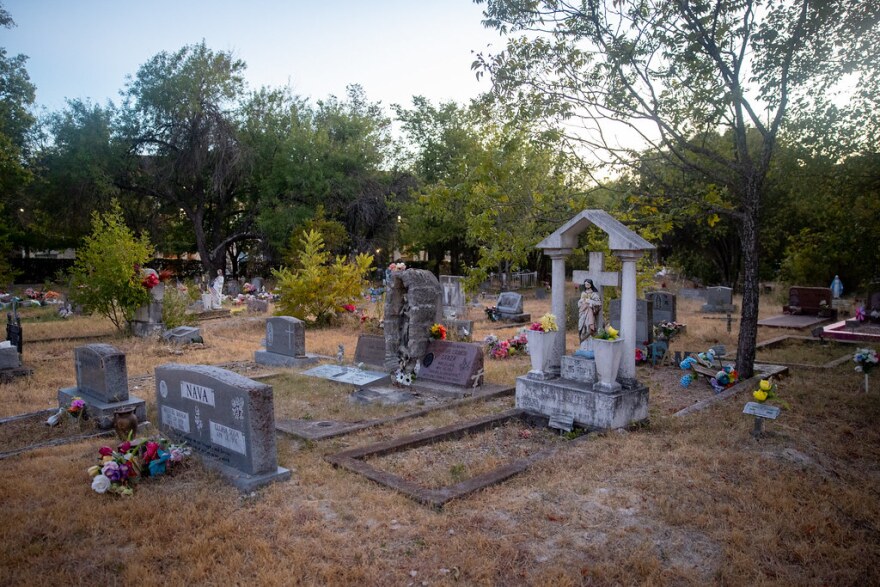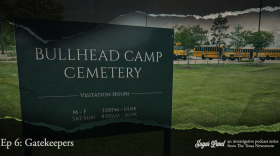Austin resident Kay Marley-Dilworth says she can communicate with the dead. (Think “I see dead people” from The Sixth Sense, but less scary.) So it’s surprising that she visits cemeteries for peace and quiet.
“When I visit cemeteries, it's usually for relaxation and downtime,” she says.
Contrary to pop culture’s portrayal of mediums, Marley-Dilworth says she doesn’t experience a lot of supernatural happenings when she’s at cemeteries.
“They don't really have any spirits of the departed,” she says. “If a spirit is going to come back, where are they gonna go? Not to the cemetery. They're gonna go see family.”
Marley-Dilworth frequently goes to the Boggy Creek Masonic Cemetery in South Austin. On one visit, she noticed Maria de la Luz, a smaller, more colorful cemetery, down the road.
She wondered, “What’s that cemetery's story?” So I met up with her there to find out.

The aesthetic of Maria de la Luz
Maria de la Luz is packed full of hand-crafted headstones and multicolored silk flower offerings. Big trees offer shade to people visiting their loved ones' gravesites.
Marley-Dilworth, who’s half white and half Mexican American, says the vibrant decorations remind her of her family’s cemetery — well, the Mexican-American side of the Maria de la Luz, that is. It’s filled with rainbow flowers, flags and wind chimes. The other side has only grave markers.
“It's funny because the side without decoration is almost always the Anglo side,” she says.
Marley-Dilworth says she loves getting a feel for the people who are buried at a cemetery by seeing the offerings at gravesites; each is an altar for the person buried below.
An orange cat statue and a small can of Dr. Pepper sit in front of one headstone. There’s also a statue of la Virgen de Guadalupe, the Virgin Mary in Mexican culture.
“Well, she's Catholic,” Marley-Dilworth says of the deceased buried below. “Clearly she liked cats, probably owned an orange tabby. She liked Dr. Pepper. I mean, she sounds like a cool person already.”
The cemetery’s origin story
As much as she likes to get to know people’s stories, Marley-Dilworth says she also likes to learn places’ stories.
To understand the history of Maria de la Luz, we have to go back to 1912. A family was traveling through what was then the community of Manchaca. They buried their child, Maria de la Luz, where the cemetery is today — hence the name. She died from some sort of sickness, according to the Austin American-Statesman.
The newspaper speculated in 2012 that Maria could be buried underneath the wood and metal shack at the center of the cemetery that was once used as a viewing room.
Dale Flatt, the chairman of the Austin Cemetery Committee and founder of Save Austin Cemeteries, says there’s no physical evidence of her body.
“We don't know where she's buried,” he says. “All we know is the origin that’s been passed down through the generations.”

The word-of-mouth story doesn’t end there. In August 1912, three farmworkers named A. Donley, A.C. Rodriguez and S. Galvan had raised money for a Mexican cemetery fund. At that time, the segregated city cemeteries were sources of shame for the Mexican community.
“For the most part, we see a drop off of Hispanics being buried in the city cemetery because they weren't welcome,” Flatt says. “So they stayed in the fringes.”
The trio wanted a space to honor their dead, so they bought the land around Maria’s grave.
Thus, the Maria de la Luz Cemetery was born.
The Maria de la Luz caretakers
Over the years, a lot of the original wooden grave markers were lost. Austin continued to grow around the small graveyard, overshadowing an important piece of Mexican culture in the city.
But people who had family buried there continued to care for the property. In the ’60s, Dario Rodriguez became the cemetery’s manager. He was in charge of keeping track of who was and would be buried at Maria de la Luz.
At the Austin History Center, I found six hardback cemetery ledgers for the cemetery. Some of the books are detached at the spine, while others have frayed threads. The records are handwritten in Spanish, and they don’t seem to be well organized. The yellowed notebook pages are filled with lists of names written in cursive.
The collection includes Rodriguez’s obituary; he died in 2008. Before he died, however, he found himself in some legal drama.
The lawsuit
By the early 2000s, Rodriguez was the only person left in charge of caring for Maria de la Luz. The work caught up to him. Visitors were swallowed up to their knees in overgrown grass and weeds.
In an interview with the Austin American-Statesman in 2003, Sandy Morris said during a visit to her family's gravesites, she was so fed up with the poor conditions of the cemetery that she vowed to rescue the grounds.
Two years later, Morris, her husband Henry and a group of plot owners sued Rodriguez. They wanted custody of the cemetery and its records.
“He believed that was his cemetery,” Flatt says. “He worked on it long enough. Nobody else cared about it. ‘Now you want to take it away from me? How dare you?’”
The suit alleged more than poor maintenance and refusal to respond to complaints.
“They started talking to people and somebody says, ‘Well, I own this space.’ And somebody goes, ‘Well, wait a minute, I own that space, too,’” Flatt says. “He was double selling spaces, putting all the money in his pocket instead of putting it into a fund for the needs of the cemetery.”
The Austin American-Statesman reported that people in the community felt like Rodriguez had betrayed their trust. Rodriguez’s lawyer denied all the claims.
A judge ruled in the families’ favor.
“The judge told the man, ‘Give them the records, you're no longer in charge of this,’” Flatt says. “They're in charge of it.”

Members of Morris’ group, the Maria de la Luz Cemetery Association, continued to make improvements to the grounds.
There are more than 2,000 bodies buried at Maria de la Luz. Rodriguez was the only one who knew where all the bodies were. Flatt used what he could from Rodriguez’s records to figure out who the unmarked graves belonged to.
It’s impossible to know if every single body buried at Maria de la Luz has been identified, but there are now organized lists of the people who have been identified, along with maps of the cemetery.
The Maria de la Luz Association
Six years after the lawsuit, Claudia Alarcón and her then-husband, Will Larson, were walking around the neighborhood when they first spotted the Maria de la Luz Cemetery. They noticed its colorful contrast to the Masonic cemetery down the street.
“It's so interesting to see the two cultures just like sitting across the street from each other,” she says.
Alarcón lived in Austin for decades before moving back to her native Mexico City to care for her mother. She says seeing the Mexican cemetery in her old Austin neighborhood touched her heart.
“Being a Mexican national and living in Austin — not just living in Austin, but living in South Austin — and identifying with that and finding this little hidden place,” she says. “I felt such an incredible connection that I felt I had to connect with the people that ran it.”

Alarcón says she and her husband were eager to help out at the cemetery. After meeting members from the Maria de la Luz Association, Larson repaired the metal sign above the cemetery’s entrance archway.
“After that we were like, ‘Well, you know, we need to promote this place because it's absolutely beautiful and nobody knows about it,’” Alarcón says.
On May 27, 2012, Alarcón and the rest of the Maria de la Luz Association hosted a celebration in honor of the cemetery’s 100th anniversary. Families and elected officials joined.
Alarcón says it’s not uncommon for there to be celebrations at the cemetery for other holidays, like Mother’s Day and Veterans Day. Sometimes there’s even a mariachi band. On holidays, families clean up and decorate the graves.
“They're really proud because there's a lot of history there,” she says.
A Mexican cemetery’s legacy
Maria de la Luz is clearly not just a place for Marley-Dilworth to go to avoid ghosts. People can go there to connect with and appreciate Mexican culture in Austin, paying respect to the people who are buried there.
“Even though I don't live in the neighborhood – or even in Austin – anymore, I'm a firm believer that, you know, we need to make sure that we speak more about the Mexican culture in Austin,” Alarcón says. “And I don't mean drinking margaritas and eating tacos. I mean, like, the people that actually moved to Austin and helped found the city and helped build the city — and a lot of those people are buried in that cemetery.”
Correction: Claudia Alarcón's name was misspelled in a previous version of this story.
Copyright 2023 KUT 90.5









